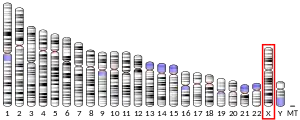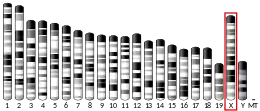| CHRDL1 | |||||||||||||||||||||||||||||||||||||||||||||||||||
|---|---|---|---|---|---|---|---|---|---|---|---|---|---|---|---|---|---|---|---|---|---|---|---|---|---|---|---|---|---|---|---|---|---|---|---|---|---|---|---|---|---|---|---|---|---|---|---|---|---|---|---|
| Identifiers | |||||||||||||||||||||||||||||||||||||||||||||||||||
| Aliases | CHRDL1, chordin-like 1, CHL, MGC1, MGCN, NRLN1, VOPT, dA141H5.1, chordin like 1 | ||||||||||||||||||||||||||||||||||||||||||||||||||
| External IDs | OMIM: 300350 MGI: 1933172 HomoloGene: 12834 GeneCards: CHRDL1 | ||||||||||||||||||||||||||||||||||||||||||||||||||
| |||||||||||||||||||||||||||||||||||||||||||||||||||
| |||||||||||||||||||||||||||||||||||||||||||||||||||
| |||||||||||||||||||||||||||||||||||||||||||||||||||
| |||||||||||||||||||||||||||||||||||||||||||||||||||
| Wikidata | |||||||||||||||||||||||||||||||||||||||||||||||||||
| |||||||||||||||||||||||||||||||||||||||||||||||||||
Chordin-like 1 is a protein that in humans is encoded by the CHRDL1 gene.[5] Chordin-Like 1 (CHRDL1) is a structural glycoprotein that sits on the X chromosome and specifically encodes Venotropin, which is an antagonistic protein to bone morphogenic protein 4.[6]
Function
This gene encodes an antagonist of bone morphogenetic protein 4. The encoded protein may play a role in topographic retinotectal projection and in the regulation of retinal angiogenesis in response to hypoxia. Alternatively spliced transcript variants encoding different isoforms have been described.[5]
CHRDL1 plays important roles in processes such as embryonic cell differentiation, osteogenesis, neurogenesis, tumor and metastasis suppression, and retinal formation.[7][8] The highest expression of this gene is found in the anterior eye segment and retina as well as in the cerebellum and neocortex.[6] In the neocortex, it peaks at the time of synapse maturation to allow for proper synaptic formation.[9] Therefore, this gene is important in proper formation of the central nervous system and the eyes.
Clinical significance
Mutations in CHRDL1 are associated to Neuhäuser Syndrome, X-linked megalocornea and central corneal thickness.[10]
Mutations in this gene may cause a variety of effects on the aforementioned processes. One potential outcome of a CHRDL1 mutation is non-syndromic X-linked megalocornea (XMC) that results from either a missense, nonsense, or frameshift mutation of the gene.[6] XMC is an enlargement of the anterior segments of the eye that may lead to other issues such as cataracts and glaucoma.[6] Another potential outcome is carcinogenic formation. Since CHRDL1 is a tumor and metastasis suppressor, a mutation in this gene may lead to tumor cell formation.[8] The most major effect a mutation could have is on synaptic stabilization. Since the gene limits synaptic plasticity, a mutation may cause issues in proper synapse maturation, leading to a variety of neurological disorders.[9] There is currently a knockout model for this gene that shows disruption may cause altered synaptic events and reduced synaptic GluA2 AMPARs leading to reduced plasticity.[9]
References
- 1 2 3 GRCh38: Ensembl release 89: ENSG00000101938 - Ensembl, May 2017
- 1 2 3 GRCm38: Ensembl release 89: ENSMUSG00000031283 - Ensembl, May 2017
- ↑ "Human PubMed Reference:". National Center for Biotechnology Information, U.S. National Library of Medicine.
- ↑ "Mouse PubMed Reference:". National Center for Biotechnology Information, U.S. National Library of Medicine.
- 1 2 "Entrez Gene: Chordin-like 1". Retrieved 2014-08-06.
- 1 2 3 4 Pfirrmann T, Emmerich D, Ruokonen P, Quandt D, Buchen R, Fischer-Zirnsak B, et al. (June 2015). "Molecular mechanism of CHRDL1-mediated X-linked megalocornea in humans and in Xenopus model". Human Molecular Genetics. 24 (11): 3119–32. doi:10.1093/hmg/ddv063. PMID 25712132.
- ↑ Liu T, Li B, Zheng XF, Jiang SD, Zhou ZZ, Xu WN, et al. (2019). "Chordin-Like 1 Improves Osteogenesis of Bone Marrow Mesenchymal Stem Cells Through Enhancing BMP4-SMAD Pathway". Frontiers in Endocrinology. 10: 360. doi:10.3389/fendo.2019.00360. PMC 6582276. PMID 31249554.
- 1 2 Pei YF, Zhang YJ, Lei Y, Wu WD, Ma TH, Liu XQ (April 2017). "Hypermethylation of the CHRDL1 promoter induces proliferation and metastasis by activating Akt and Erk in gastric cancer". Oncotarget. 8 (14): 23155–23166. doi:10.18632/oncotarget.15513. PMC 5410293. PMID 28423564.
- 1 2 3 Blanco-Suarez E, Liu TF, Kopelevich A, Allen NJ (December 2018). "Astrocyte-Secreted Chordin-like 1 Drives Synapse Maturation and Limits Plasticity by Increasing Synaptic GluA2 AMPA Receptors". Neuron. 100 (5): 1116–1132.e13. doi:10.1016/j.neuron.2018.09.043. PMC 6382071. PMID 30344043.
- ↑ Davidson AE, Cheong SS, Hysi PG, Venturini C, Plagnol V, Ruddle JB, et al. (2014). "Association of CHRDL1 mutations and variants with X-linked megalocornea, Neuhäuser syndrome and central corneal thickness". PLOS ONE. 9 (8): e104163. Bibcode:2014PLoSO...9j4163D. doi:10.1371/journal.pone.0104163. PMC 4122416. PMID 25093588.
Further reading
- Sakuta H, Suzuki R, Takahashi H, Kato A, Shintani T, Yamamoto TS, et al. (July 2001). "Ventroptin: a BMP-4 antagonist expressed in a double-gradient pattern in the retina". Science. 293 (5527): 111–5. doi:10.1126/science.1058379. PMID 11441185. S2CID 32368073.
- Webb TR, Matarin M, Gardner JC, Kelberman D, Hassan H, Ang W, et al. (February 2012). "X-linked megalocornea caused by mutations in CHRDL1 identifies an essential role for ventroptin in anterior segment development". American Journal of Human Genetics. 90 (2): 247–59. doi:10.1016/j.ajhg.2011.12.019. PMC 3276677. PMID 22284829.
- Kane R, Godson C, O'Brien C (June 2008). "Chordin-like 1, a bone morphogenetic protein-4 antagonist, is upregulated by hypoxia in human retinal pericytes and plays a role in regulating angiogenesis". Molecular Vision. 14: 1138–48. PMC 2435163. PMID 18587495.
- Fernandes H, Dechering K, van Someren E, Steeghs I, Apotheker M, Mentink A, et al. (2010). "Effect of chordin-like 1 on MC3T3-E1 and human mesenchymal stem cells". Cells Tissues Organs. 191 (6): 443–52. doi:10.1159/000281825. PMID 20130390. S2CID 39732221.
- Coronary Artery Disease (C4D) Genetics Consortium (March 2011). "A genome-wide association study in Europeans and South Asians identifies five new loci for coronary artery disease". Nature Genetics. 43 (4): 339–44. doi:10.1038/ng.782. PMID 21378988. S2CID 39712343.
{{cite journal}}: CS1 maint: numeric names: authors list (link) - Larman BW, Karolak MJ, Adams DC, Oxburgh L (May 2009). "Chordin-like 1 and twisted gastrulation 1 regulate BMP signaling following kidney injury". Journal of the American Society of Nephrology. 20 (5): 1020–31. doi:10.1681/ASN.2008070768. PMC 2678041. PMID 19357253.
- Coffinier C, Tran U, Larraín J, De Robertis EM (January 2001). "Neuralin-1 is a novel Chordin-related molecule expressed in the mouse neural plate". Mechanisms of Development. 100 (1): 119–22. doi:10.1016/s0925-4773(00)00507-4. PMID 11118896.
- Gazzerro E, Canalis E (June 2006). "Bone morphogenetic proteins and their antagonists". Reviews in Endocrine & Metabolic Disorders. 7 (1–2): 51–65. doi:10.1007/s11154-006-9000-6. PMID 17029022. S2CID 20907947.
- Chen D, Zhao M, Mundy GR (December 2004). "Bone morphogenetic proteins". Growth Factors. 22 (4): 233–41. doi:10.1080/08977190412331279890. PMID 15621726. S2CID 22932278.
This article incorporates text from the United States National Library of Medicine, which is in the public domain.



